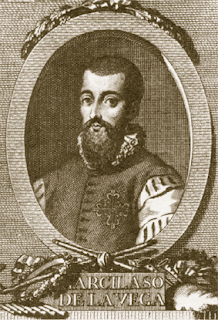The origin of the word “Perú”
A story about the name of Peru can be traced back to the works of Gómez Suárez de Figueroa better known as Garcilaso de la Vega (1539 – 1616).
A little about Garcilaso de la Vega, he was the illegitimate son of a Spanish conquistador Sebastián Garcilaso de la Vega Vargas and an Inca princess Palla Chimpu Ocllo (later baptized Isabel) this was frowned upon and as result the son was denied the right to have the surname of father, surnames were a status symbol especially that of Sebastián as he came from a noble lineage. Garcilaso de la Vega grew up with his mother and her family this is where he learnt how to speak Quechua and learnt about culture and history of the Inca Empire. Due to his father’s influence he studied at la Escuela de Mestizos de Juan Cuella where he learnt how to speak Latin and the Catholicism.
In 1609 The Royal Commentaries of the Inca’s (Comentarios Reales de los Incas) his most well-known work was published, documenting and detailing the history of the Inca’s and of the Spanish conquest of Peru, it is also in this book we can find the story of the name of Perú.
The story starts with Vasco Núñez de Balboa (1475-1519) a well-known explorer and conquistador who crossed the Isthmus of Panama to the Pacific Ocean in 1513. He built many ships and many went across the Pacific Ocean in the hope of finding more land to conquer. In one such case it is said that one ship sailed to close to the coast of what is now known as South America and at an estuary the crew spotted an indigenous fisherman and captured him and brought him aboard the ship. The Spaniards then proceeded to question him about the unknown land using sign language and gestures. The fisherman now scared and confused and wanting to please his captors he blurted out the word “Berú,” which is said to have been his name. The fisherman then spoke another word “Pelú,” meaning river. The Spanish somehow merged these words together to form the word Perú.
According to Garcilaso the name of Perú was unknown to the indigenous population for about 70 years after the conquest and the indigenous population still referred the land they lived in as Tawantinsuyu, the name the Inca’s called it. The Spanish in the decided to call the country Berú however this was only used in the coastal areas and was not used in the highlands. Garcilaso also mentions in his chronicle that most names given to places in the America’s were actually misunderstandings between the native population and the Spaniards and the Spaniards always believe that the native people they questioned always understood them like they were speaking the same language.
The name origins of Perú is difficult to track due the many different accounts and stories that surround it but what is certain is the Perú is not word which originates from Quechua.
Some historians contest the chronicles by Garcilaso due to the fact that that some of his work contradicts work of other chronicles which also wrote in the same period. This also casts doubt on the name origin of Perú, the result of a tall tale or is it based on truth?























0 comentarios: